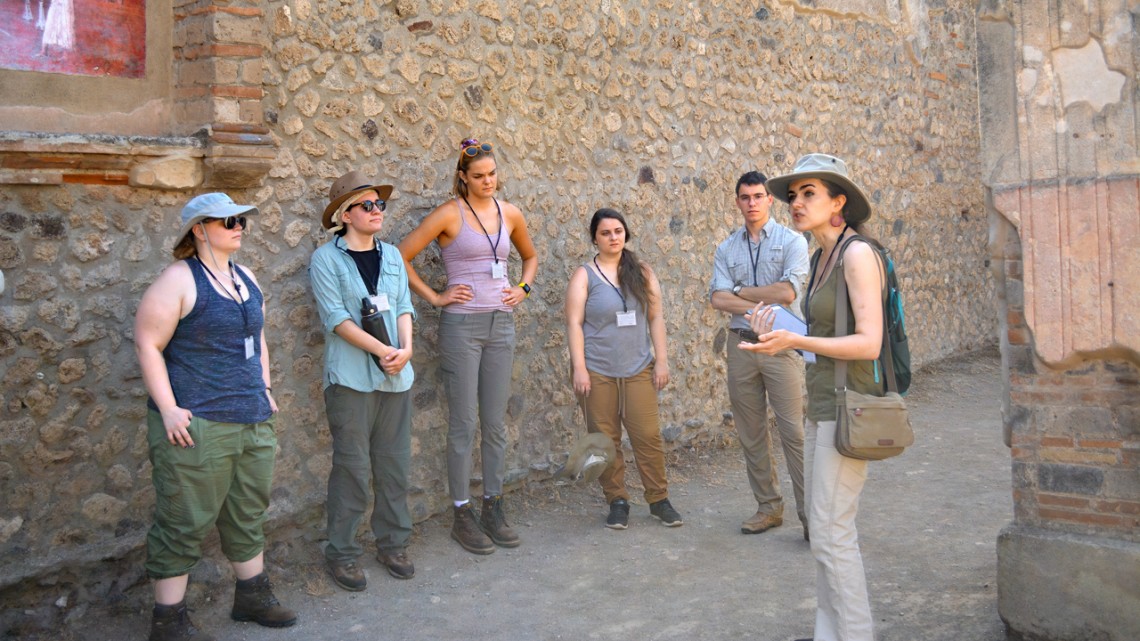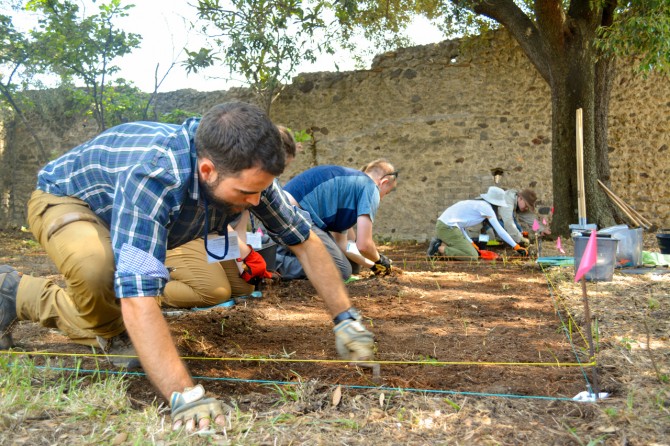
Associate professor Caitlín Barrett, right, takes the Casa della Regina Carolina Project group on a tour of Pompeii.
Faculty forge archaeology partnership at Pompeii
By Joe Wilensky
Caitlín Barrett, associate professor of classics in the College of Arts and Sciences, and Kathryn Gleason ’79, professor of landscape architecture in the College of Agriculture and Life Sciences, have been collaborating since 2016 on the excavation and survey of a large house and garden site, the Casa della Regina Carolina Project, at Pompeii in southern Italy. They are faculty members in the Cornell Institute of Archaeology and Material Studies (CIAMS), which supports multidisciplinary partnerships on projects across colleges.
At the Pompeii site – where they also are collaborating with their colleague and co-director, professor Annalisa Marzano of the University of Reading – they are studying the relationships in this ancient Roman city between domestic material culture, social performance and historical change through the lens of daily household life.
How did your backgrounds and work bring you together?
Caitlín Barrett: Archaeology is an inherently collaborative, multidisciplinary field. There’s really no way to do an archaeological dig today without relying on the expertise of collaborators in many fields.
Before I started working with Kathy, I had a different research project at Pompeii. I was writing a book on Egyptian landscapes in Roman art and what they tell us about the relationship between Rome and Egypt. I hadn’t expected that project to turn into a book about Roman gardens! But it did – because, it turns out, that’s where paintings and mosaics of Egyptian landscapes were most often located at Pompeii: in domestic gardens.
That got me interested in the role of gardens in Roman households. Gardens occupy a kind of liminal space: they’re inside, but also outside; they’re part of the house, but they’re also not part of the house. So in some ways, they were spaces where people could engage in different activities and try out different identities than might be appropriate in other areas of the house. For example, foreign or exotic imagery (like the Egyptian scenes) is more common in gardens than elsewhere. And in contrast to some other rooms that were more about public display – like the atrium and tablinum, where people held business meetings at home – gardens were spaces for private relaxation with invited guests, where people could let their hair down a little more.
Once I started researching gardens, that brought me to Kathy, because she’s one of the world’s foremost experts on garden archaeology and has created new methodologies for excavating gardens. And so I was very lucky to wind up at Cornell where she happened to be.
Kathryn Gleason: I, too, have been studying East-West relations in the Mediterranean and had recently finished excavating a large garden at nearby Stabiae, also buried by Vesuvius.
I came to archaeology initially out of landscape architecture. As an undergraduate at Cornell, I became interested in the sophisticated representations of garden design in ancient Egyptian, Mesopotamian and Roman art.
So I went off on archaeological excavations in the late ’70s and early ’80s to see what archaeologists were finding when they got outside the walls of the buildings. And it turned out they usually turned around and went back inside. Few archaeologists outside of Pompeii had a concept that gardens could be preserved after 2,000 or more years – or had a cultural concept of gardens to drive scholarly investigation.
As a design historian, I’m very interested in how these gardens came to be – what was the intention of the owner in creating the garden? What can the remains of a garden tell us about how that original intention was transformed into the built garden?
What collaborations are typically required at a site like this?
Barrett: For modern archaeological projects, you need a really broad team that includes both humanists and scientists. For example, you need a geophysicist who can do ground-penetrating radar or other types of below-ground sensing.
Gleason: At our site, that’s Larry Brown here at Cornell (the Sidney Kaufman Professor in Geophysics in the Department of Earth and Atmospheric Sciences).
Barrett: You need an architect who can analyze the architecture and produce plans – and we also work with a LiDAR team that is creating a 3D model of the house via laser scanning. You need archaeobotanists and faunal analysts, who study plant remains and animal bones. At Pompeii, you need art historians who can relate domestic decoration to social practices. You need specialists for different finds and conservators to preserve those finds.
In gardens, environmental reconstruction is especially important. We’re working with a micromorphologist, a type of soil specialist who conducts microscopic analysis on excavated sediments, and a palynologist, who studies ancient pollen.
Gleason: Our role as archaeologists is to bring together the work of all these specialists to piece together the full ecology of the garden, as well as its design, ornamental features and its place in the life of the household. Garden plants are just one part – the most ephemeral part – of that complex cultural and natural system.
Barrett: We’re trying to figure out what life was like for the people who inhabited this house. What were their experiences? How did this garden shape their lives?
What else have you learned through your work at this site?
Gleason: I am always asked if we are excavating an ornamental garden or a produce garden. It’s actually during the Roman period that the ancient texts make this distinction. The emerging archaeological evidence suggests that our garden was both – featuring plants that were highly ornamental, while at the same time offering delicious fruits, nuts or herbs.
Barrett: We’re also asking how domestic production connected households to larger economies. We often think of gardens as places of display and relaxation, and they definitely could be that, but they were also places of production. People could grow crops for their own use or for sale. The plants grown here could also have been imported from far away. So gardens like this could participate in potentially very extensive economic networks.
Gleason: One thing to note is that our house is just large and luxurious enough to suggest that those who designed and managed the gardens were not the owners, but slaves. In the Roman era, the architects and the engineers, the garden designers, the garden maintenance staff were typically slaves of varied status. Our project manager, Kaja Tally-Schumacher ’20, is looking at the different types of labor that would have been required to maintain an expensive garden, as well as to initially build it.
How much student connection is there with this site and this project?
Barrett: A lot of the team members are grad students who supervise excavation trenches or take on other leadership roles, like supervising the flotation of soil samples. Many of them will contribute to our publication as well.
Gleason: Undergraduate students also have been able to work at the site thanks to very generous funding support to CIAMS.
Barrett: Yes – the Lewin Family Gift Fund and the Hirsch Undergraduate and Graduate Archaeological Research and Travel Grants have provided incredibly important support, allowing us to get students into the field, to train them, and to let them have that potentially transformative experience of excavating and living and working abroad. So we’re very grateful to those donors for supporting our students.
How does the fieldwork relate to your teaching?
Barrett: It’s definitely a complementary relationship. I’m currently teaching an undergraduate survey course, Great Discoveries in Greek and Roman Archaeology. When we do our module on Pompeii, I talk about our excavation and tell them about ways that they can get involved. One of our team members last year volunteered for the project after taking that course. So it’s a lot of fun for me, and hopefully also for the students, when the classroom and the field contribute to each other.
Gleason: I have had the same experience with my Rome seminar, but I primarily teach modern landscape architecture. The deep sense of time that I have gained from looking at the morphology of a particular piece of land across 2,000 years has given me a unique perspective on teaching design for future landscapes in the United States. My design studios challenge the students to design the Americas – not as a New World, but as ancient landscapes with cultures that go back millennia.
And that’s really, broadly speaking, why one engages in the study of the classical humanities: to see and be aware of the impact of more than 2,000 years of knowledge in our current thinking.
Barrett: When I was a student, one of my first field projects was in Egypt, and I remember one find in particular: a little leather shoe that was worn by a child thousands of years ago. You could see how the foot of the child had literally molded the shoe to their body – and that physical trace of this person’s life was so emotionally resonant. That early experience of fieldwork just absolutely changed the course of my career and my life.
So it’s important to me to make that experience as accessible to students as I possibly can, so that they have a chance to explore their interests and passions too.
What is something each of you has learned from the other?
Barrett: It’s been wonderful to learn from Kathy’s expertise and experience – she has been a real mentor. And it’s also particularly valuable for me, in a traditionally male-dominated discipline, to have female colleagues and mentors who are leaders in this field. We didn’t design it this way intentionally, but this project wound up being entirely female-led, which is still actually fairly unusual in archaeology.
And it’s been really helpful for me, as a woman and a mother in the field, to be able to draw on Kathy’s experience with similar commitments and challenges.
Gleason: I am learning as much as I am teaching. It is exciting to see how Caitie and the new generation of scholars are taking my generation’s work in important new directions.
One of the great advantages of co-directing is that we’ve been able to balance the direction of the work with the demands on each of us in our lives. We do fieldwork on top of everything else a professor normally does, so we have to make this experience not only productive academically but also a workable – and, ideally, exciting – part of our families’ lives.
Media Contact
Get Cornell news delivered right to your inbox.
Subscribe


